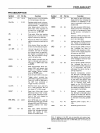
8291
When the
8291
is addressed
to
talk, it uses the data-out
register
to
move data onto the GPIB. Upon a write to this
register, the
8291
initiates and completes the handshake
while sending the byte out over the bus. When the
I nterrupt Registers
I
CPT
I
APT
I
GET
I
ENO
OEC
I
ERR
BO
BI
INTERRUPT STATUS 1
II
R)
liNT
I
SPAS
I
LLO
I
REM
I SPAscl
LLOC
I
REMCI
ADSC
I
INTERRUPT STATUS 2
12R)
The
8291
can be configured to generate
an
interrupt
to
the
microprocessor upon the occurrence
of
any of
12
conditions
or
events on the GPIB. Upon receipt of
an
interrupt, the microprocessor must read the Interrupt
Status
registers to determine which event has occurred,
and then execute the appropriate service routine (if
necessary). Each of the
12
interrupt status bits has a
matching enable bit in the interrupt enable registers.
These enable
bits
are used
to
select the events
that
will
cause the INT pin
to
be asserted. Writing a logic
"1"
into
any
of
these bits enables the corresponding interrupt
status bits to generate
an
interrupt. Bits in the Interrupt
RFO/OAV
holdoff mode
is
in effect, data is held until the
release command is issued. Also, a read of the data-in
register does not destroy the information in the data-out
register.
I
CPT
I
APT
I
GET
I
END
I
DEC
I
ERR
BO
BI
I
INTERRUPT ENABLE 1 I1W)
I 0 I 0 I
DMAOI
DMAI
I SPAscl LLOC I
REMCI
ADscl
INTERRUPT ENABLE 2 (2W)
Status registers are set regardless
of
the states
of
the
enable bits. The
Interrupt Status registers are then
cleared upon being read
or
when a local pon (power·on)
message is executed. If
an
event occurs while one
of
the
Interrupt Status registers is being read, the event is
typically held until after its register is cleared and then
placed in the register.
The mnemonics for each of the bits in these registers and a
brief description of their respective functions appears in
Table
4.
This table also indicates how each of the interrupt
bits
is
set.
TABLE
4.
Interrupt Bits
Indicates Undefined Commands
Set by (TPAS + LPAS)oSCGoACOSoMODE 3
Set by DTAS
Set
by
(EOS
+ EOI)oLACS
Set
by OCAS
Set
by TACS.nbaoOAC.RFO
TACSo(SWNS
+ SGNS)
Set
by LACS.ACOS
Shows
status of the INT pin
The device has been enabled
for
a serial poll
The device is in local lock out state.
(LWLS+RWLS)
The device is in a remote state.
(REMS+RWLS)
CPT
APT
GET
END
DEC
ERR
BO
BI
'----
INT
SPAS
LLO
~
An
undefined command has been received.
A secondary address must
be
""assed
through
to the microprocessor
for
recognition.
A group execute trigger has occurred.
An
EOS
or
EOI
message
has
been received.
Device Clear Active
State has occurred.
Interface error has occurred; no listeners
are active.
A byte should be output.
t
A byte has been input.
I-
These are status only. They will not generate
interrupts,
nor
do they have corresponding
mask bits.
SPAS-SPAS
SPASC Serial Poll Active State change
interrupt.t
---
LLCNO
LLO LLOC Local lock out change interrupt.
Remoti:~Jocal
REMC Remote/Local change interrupt.
AddressedUnaddressed
AOSC Address status change
interrupt:
--
tSee
section on 8291A compatibility.
'In
ton (talk-only) and Ion (listen·only) modes, no ADSC interrupt Is generated.
9-89


















